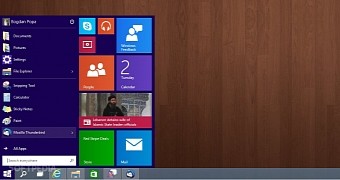A few days ago, Gabriel Aul, head of the Windows Insider Program, confirmed in a short tweet that Windows 10 would also launch with a 32-bit SKU, thus putting an end to some weird rumors pointing out that Microsoft wants to step away from this architecture type with the new OS version.
In new tweets posted today, Aul also talks more about the need to develop Windows 10 for 32-bit configurations, explaining that, despite what many people think, this particular CPU architecture is still being used by many Windows customers out there.
The Microsoftie previously said that there were “100s of millions of existing 32bit PCs that are upgradeable,” suggesting that, without a 32-bit version of Windows 10, all these computers would have to stick to an older Windows version or move to a completely different platform, most likely Linux.
Nearly 71 million 32-bit Windows PCs spotted last month
As far as statistics are concerned, Aul also reveals that, in December 2014, a total of 70.6 million computers with a 32-bit architecture connected to Windows Update to get the latest patches released by Microsoft.
Obviously, the number of such PCs is even bigger because not all are getting patches via Windows Update, while others delay the patching process or do not have an Internet connection, so they cannot be counted in.
At the same time, Aul also explains that working on a 32-bit version of Windows 10 “doesn’t affect development time,” but instead “costs more in build servers to produce.”
New PCs almost entirely on 64-bit
While in Windows 10’s case it’s pretty clear that a 32-bit version would be part of the rollout, things could change for the next Windows version, as customers are quickly migrating to 64-bit setups for new computers.
Gabriel Aul claims that, in the case of new computers with a BIOS age less than 1 year old, the percentage is impressively in the favor of 64-bit architectures. No less than 92.8 percent of the new PCs sold worldwide and running Windows are powered by a 64-bit of the company’s operating system, he says.
Windows 10, in both 32- and 64-bit versions, should arrive in late summer or early fall 2015, while new information on the project is expected to be shared this month, during a consumer event in Redmond.
@j_brorsson Still 100s of millions of existing 32bit PCs that are upgradeable.
— Gabriel Aul (@GabeAul) January 8, 2015
@j_brorsson We haven't perfected ability to publish a new CPU over WU yet. They get all squishy when the NIC spits them out...
— Gabriel Aul (@GabeAul) January 8, 2015
@j_brorsson Well, 70.6M 32bit Arch systems talked to Windows Update last month, so that's a goodly number and isn't 100% of them.
— Gabriel Aul (@GabeAul) January 8, 2015
@j_brorsson It doesn't affect our development time, just costs us more in build servers to produce. Archs * languages * editions = builds
— Gabriel Aul (@GabeAul) January 8, 2015
@j_brorsson Very close. 92.8% of systems with a BIOS age < 1yr are 64bit.
— Gabriel Aul (@GabeAul) January 8, 2015

 14 DAY TRIAL //
14 DAY TRIAL //